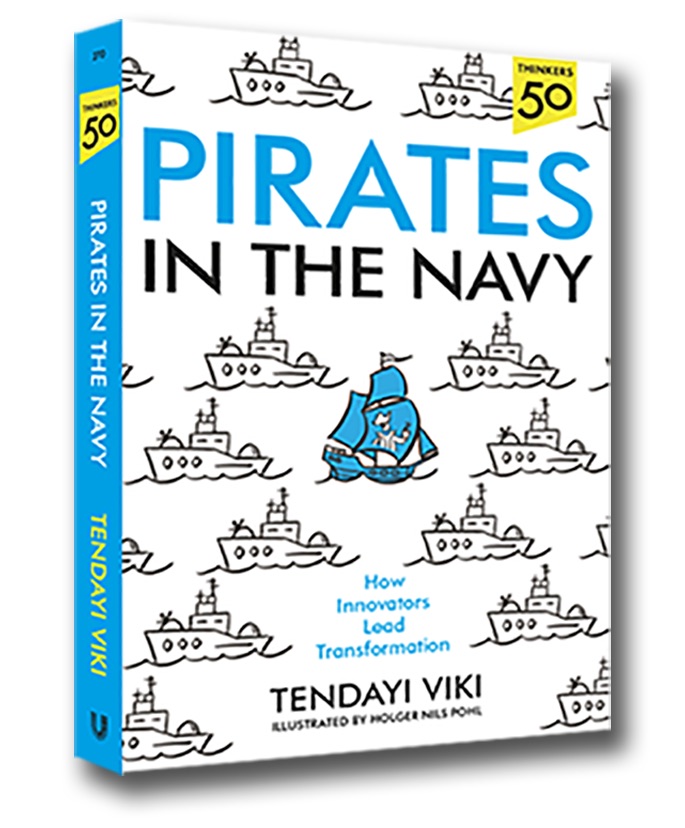This InnovationTraining.org guest article from Tendayi Viki is a selection from his latest book, Pirates In The Navy.
On Understanding Your Company Before You Start Innovating
A lot of innovators that I have met are impatient people. By the time we start working together, they are already fed up with their company. They know something needs to be done and they just want to jump in and get started. So they will take whatever opportunity they get and run with it.
I believe that this is the wrong approach. As much as we are keen to get started, it is also important to ensure that we are working on the right things. This is a lesson I learned from making many mistakes in my own work. I was often happy to take whatever innovation project the leadership team threw my way. And I have done it all – idea jams, hackathons, startup weekends, training workshops and innovation sprints. It did not matter whether what I was working on was the right thing for the company at that time or not.
“You’ve got to start somewhere”, I often hear intrapreneurs say. In my opinion, this is true and I couldn’t agree more. But it is important to recognize that this statement does not mean that, “You’ve got to start anywhere!” There is a difference.
While you have to start somewhere, it is important that you choose the right place to start. When you are trying to create a repeatable innovation process, you can’t just start anywhere by doing random activities. You have to first develop a deep understanding of your company. As such, the first question for you to answer is – how ready is your company to support and nurture innovation?
Innovation Readiness
At Strategyzer, we have developed a framework for assessing whether or not a company is ready to support innovation. There are three main elements that intrapreneurs need to think about before they start working; Leadership Support Organization Design and Innovation Practice.
Leadership Support: Without explicit and visible support from our leadership, most innovation programs are dead on arrival. Leadership support needs to go beyond just words that encourage innovation to doing the following:
- Strategic Guidance: Leaders must provide innovation teams with an innovation strategy that makes explicit where to play. This strategic guidance must be clear or known by most people within the organization.
- Resource Allocation: In a lot of companies, there are no official resources for innovation. Instead, intrapreneurs have to hustle and scrape for resources that can be pulled from them at any moment. Leaders need to make sure that they are allocating budget, time and resources that are protected from encroachment by the core business.
- Portfolio Management: Innovation cannot flourish if the leadership are exclusively focused on running and improving their core business. Instead, leaders need to be actively involved in making investments to explore future opportunities for growth.
Organizational Design: Beyond leadership, we also need to design our company structures to support innovation. As intrapreneurs, we have to build enablers and remove blockers for innovation practice to flourish:
- Legitimacy And Power: If innovation teams have to constantly fight for their right to exist, then innovation has little legitimacy or power within your company. While being a pirate might be fun, innovation is more sustainable when it is an explicit part of our institutional structures.
- Bridge To The Core: It is often difficult for innovation teams and the core business to collaborate. In fact, there can be conflict for resources, which the core business inevitably wins. As such, we need clear policies that help innovation teams collaborate with the core business.
- Rewards And Incentives: Most companies manage innovation using the same rewards and incentives systems as the core business. The annual targets and review process for bonuses makes it difficult to celebrate failure. Innovation needs to have a dedicated and different incentives system.
Innovation Practice: Innovation cannot be done using the same tools and practices that we use within the core business. Planning and executing are not the right process for innovation. Instead, innovators need to use an iterative process to design and test their ideas:
- Innovation Tools: Companies need to adopt the right tools for designing business models and testing assumptions. Adopting agile development, business model, lean startup and design thinking tools will help facilitate the innovation process. These tools need company wide adoption, rather than adoption in small pockets of the company.
- Process Management: As already noted, innovation teams need to adopt iterative methods for testing and reducing risk. In line with this best practice, our processes for managing innovation should be optimized to systematically track and measure how well teams are reducing the level of risk in new ideas.
- Skills Development: It is a myth that entrepreneurship cannot be learned. It is possible to develop and train innovation skills within our teams. Beyond training, we also need to give people the experience of working on and running innovation projects. Such skills training should be provided across the whole organization, including people in departments such as HR and finance.
So before launching our innovation projects, we have to discover the lay of the land. We have to find out how ready the company is to support innovation. We can only do this via the process of discovery.

Start With Discovery
It is often the case that you are not the first person in your company to ever try to innovate. If you look around hard enough, you will find others who have tried before you. This is the best place to start your discovery process. If you want to succeed, you need to take the time to learn from these people.
For example, they can help you to find answers to the following questions:
- Where are all the corporate traps and bureaucracy?
- Which stakeholders are the most difficult? Which one are most supportive?
- Are there any early adopters of innovation within the company who you might target and work with first?
- What other innovation programs are being run within your company at the moment? What challenges are they facing?
Do not limit your conversations to only those innovators that remain in the company. Learn what you can about the people who tried to innovate, were knocked back and left the company. Is there anybody still in touch with them or knows where they are now? Can they give you names or introduce you so that you can meet them and learn from their experiences too? Invite these former employees for coffee or a drink so that you can have a chat and pick their brains.
As you do your discovery work, make sure that you talk to all key stakeholders within your company. Don’t just talk to those that work directly on products and business models. To succeed, you will need support from other stakeholders such as Legal, Compliance, Brand, Finance, Marketing and Human Resources. Explore and discover the challenges they face when they try to work with innovation.

Be Authentic
Nobody wants to work with a know-it-all who thinks they are going to save the company. These people are actually very annoying. Some of the worst characters I have met are former startup founders who sold their last company and are now moonlighting as corporate innovators. These people will completely ignore key stakeholders or treat them like something stuck to their shoes.
What they fail to realise is that a lot of middle managers are quite adept at quietly frustrating innovation efforts. In fact, they have years of experience doing this. They have been in the company for a while and have many high level connections. So once the word goes around that you are a jerk, it’s over for you.
Let’s face it – the only way to really connect with people and get them on board is to leave your ego at the door. So as you conduct you the discovery, keep the following things in mind:
- Listen Carefully: You have to look at this whole discovery journey as not only a process of learning but also a process of building future alliances, so listen to what is being said and not just what you want to hear.
- Keep an open mind: It is very important to not let your own biases influence what you are prepared to learn along the way and the changes you may have to make. There is no value in discovery if you ignore the lessons you could be learning and just press on with the original plan.
- Authenticity is the key: At the end of the journey, make a thorough and honest review of what you have learned and use that to decide your next steps in the process.
I hope you will check out my latest book Pirates In The Navy to learn more about the next steps you need to follow – so you can use what you have learned during discovery to build a great innovation ecosystem.
